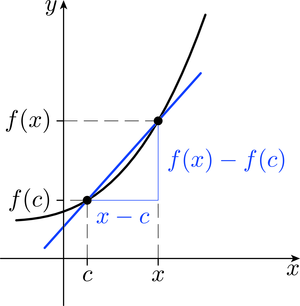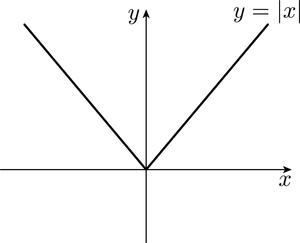Introduction to complex analysis
Session 1: Differentiation
Introduction to differentiation
The derivative of a real function at a point is the gradient of the tangent to the graph of at . This gradient is calculated by finding the gradient of the chord joining the point to a (nearby) point , and taking the limit as approaches (Figure 1).
Now, the gradient of the chord is equal to the ratio
This ratio is often called the difference quotient for at , and its limit as tends to provides a formal definition of the (real) derivative of at , denoted by . Thus
In the case of complex functions, it is difficult to think about derivatives in terms of gradients of tangents, since the graph of a complex function is not drawn in two dimensions. Instead we define the derivative of a complex function directly in terms of difference quotients, using the notion of complex limits.
Fortunately, the derivatives of many complex functions turn out to have the same form as those of the corresponding real functions. For example, the derivative of the complex sine function is the complex cosine function, and the complex exponential function is its own derivative. On the other hand, the complex modulus function fails to be differentiable at any point of , even though the real modulus function (Figure 2) is differentiable at every point of . This reflects the fact that complex differentiation imposes a much stronger condition on functions than does real differentiation. Indeed, as the course progresses, you will see that differentiable complex functions have remarkably pleasant properties. For example, if a complex function can be differentiated once throughout a region, then it can be differentiated any number of times. There is no equivalent result for real functions.
Section 1 will define complex differentiation and show how the definition can be used to establish whether a function is differentiable. By introducing rules for combining differentiable functions, you will see how complex polynomial and rational functions can be differentiated just as in the real case. The end of Section 1 will give a geometric interpretation of complex differentiation by introducing the idea of a complex scale factor.
Section 2 will introduce the concept of partial differentiation for real functions of two real variables, and use it to establish a relationship between complex differentiation and real differentiation. This relationship sometimes enables us to differentiate a complex function using real derivatives. Indeed, at the end of the section, this approach will be used to show that the complex exponential function is its own derivative.
Box _unit1.1.1
This OpenLearn course is an extract from the Open University course M337 Complex analysis [Tip: hold Ctrl and click a link to open it in a new tab. (Hide tip)] .


